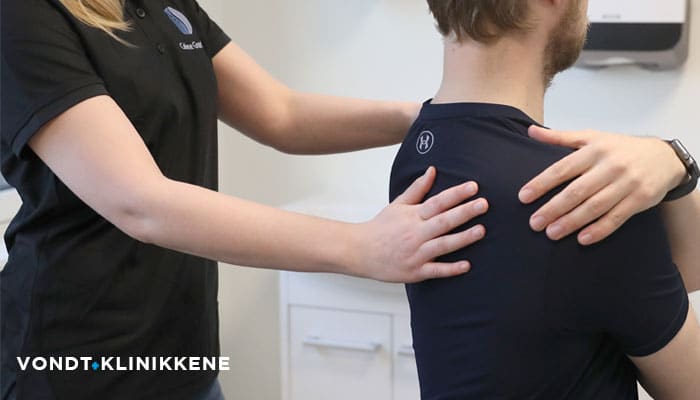
Iliotibial band syndrome (Pain on the outside of the knee)
Pain on the outside of the knee when jogging? Iliotibial band syndrome is one of the most common causes of diffuse pain on the outside of the knee / lower thigh for those who love to jog - and especially those who increase the amount of exercise too fast. The diagnosis is also called tensor fascia latae tendinitis, iliotibial band friction syndrome and ITB syndrome.
The cause of ITB Syndrome
The condition occurs due to long-term friction over the iliotibial band tendon - which leads to tendon irritation / tendon damage. This occurs in particular when the tensor fascia latae muscle / iliotibial ligament rubs against the lateral epicondyle of the knee at 30-40 degrees of knee flexion (partially bent position). Running has a very high number of flexion (inward bending) and extension (outward bending) movements, which means that joggers in particular are prone to this diagnosis. Weak gluteal muscles are also considered a major contributing factor to this diagnosis and knee problems in general.
The Pain Clinics: Our Interdisciplinary and Modern Clinics
Our clinic departments at Vondtklinikkene (click here for a complete overview of our clinics) has a distinctively high level of professional expertise in the investigation, treatment and rehabilitation of knee diagnoses. Contact us if you want the help of therapists with expertise in knee pain.
Predisposing risk factors
There are 10 factors in particular that increase the chance of you getting ITB syndrome:
1. Anatomically thickened iliotibial bands / congenital misalignment in the hip
2. Overweight
3. Overtraining - "too much, too fast"
4. Overpronation (collapse in the arch of the foot) in the foot - leads to increased medial rotation in the knee
5. Underpronation in the foot - leads to increased load on the knee from the inside out, which puts increased pressure on the iliotibial ligament
6. Bad shock absorbing shoes
7. Running on hard surfaces (asphalt) without sufficient muscular capacity to run on it
8. Anterior cruciate ligament instability
9. Too high bicycle seat - leads to irritation against ITB due to pedaling
10. Leg length difference (functional, eg due to pelvic / lower back or structural joint restriction)
Symptoms of iliotibial band syndrome
A patient with ITB syndrome will normally present with diffuse pain over the lateral aspect of the knee and lower thigh - which he feels mainly when running. The pain is aggravated by jogging downhill and especially when the leg is on the way up and forward. There will also be pressure soreness in the area where the ITB crosses the lateral femoral condyle.
Relief and load management for ITB syndrome and knee pain
If you are affected by ITB syndrome, it may be wise to think a little extra about relief and load management. A simple and ingenious self-measure, which is easy to use, is nn knee compression support. In short, such supports contribute to improved stability in the knee, while at the same time stimulating increased blood circulation towards the painful and injured areas. In other words, it is very nice to use when you have knee problems - but can also be used preventively.
Tips: Knee compression support (The link opens in a new window)
Click on the image or link to read more about the knee compression support and how it can help your knee.
Clinical signs / orthopedic tests
Ober's test
Nobel's test
Clean tests
These tests will help a clinician diagnose this problem. It is also important that the clinician checks the knee for instability, as well as checks the legs for leg length differences.
Treatment of ITB syndrome
The first stage of treatment is aimed at rest, relief and cryotherapy / ice massage. It is recommended that you temporarily step down on the run (and especially in rough terrain), often in exchange with low-impact training, such as swimming and an elliptical machine.
There should also be a focus on good joint function in the lower back, pelvis and hip, as this diagnosis can often cause such 'sequelae'. A officially approved chiropractor or manual therapist can help you assess this. Also ask for an evaluation of the gait, ankle and foot to see if you can benefit from sole adjustment - e.g. due to weak arch muscles or flat feet / pes planus. We point out that sole adjustment is not a 'magic quick fix', but rather that it can be a small step in a positive direction.
Further treatment techniques that can be used are cross-friction massage against the iliotibial band, instrumental tendon therapy (graston) and myofascial therapy (intramuscular needle therapy and muscular techniques). Anti-inflammatory laser can also be used as a supplement in treatment.
Exercise and training against ITB syndrome
The patient should be instructed in seat / glutes, hamstrings and hip abductors. This in combination with exercise to strengthen the seat muscles and the hip stabilizing muscles.
NEXT PAGE: - Sore knee? You should know this!
Also read: - The Worst Exercises If You Have Prolapse
Also read: - 6 Effective Strength Exercises for Sore Knee
Sources:
-
Questions asked about iliotibial band syndrome / iliotibial band syndrome / pain on the outside of the lower knee / tensor fascia latae tendinitis, iliotibial band friction syndrome and ITB syndrome:
-
 Follow Vondt.net on YOUTUBE
Follow Vondt.net on YOUTUBE
(Follow and comment if you want us to make a video with specific exercises or elaborations for exactly YOUR issues)
 Follow Vondt.net on FACEBOOK
Follow Vondt.net on FACEBOOK
(We try to respond to all messages and questions within 24-48 hours. We can also help you interpret MRI responses and the like.)










Leave a reply
Want to join the discussion?Feel free to Contribute!